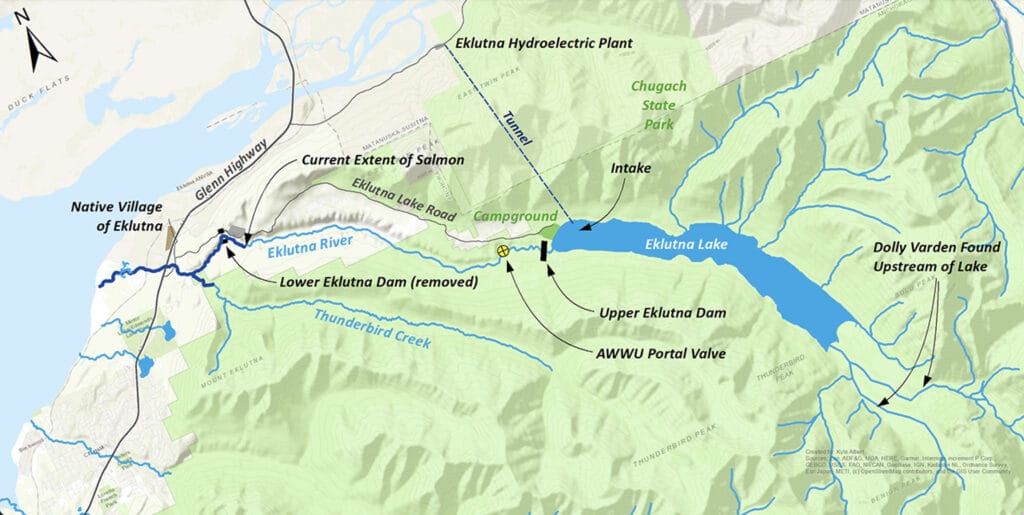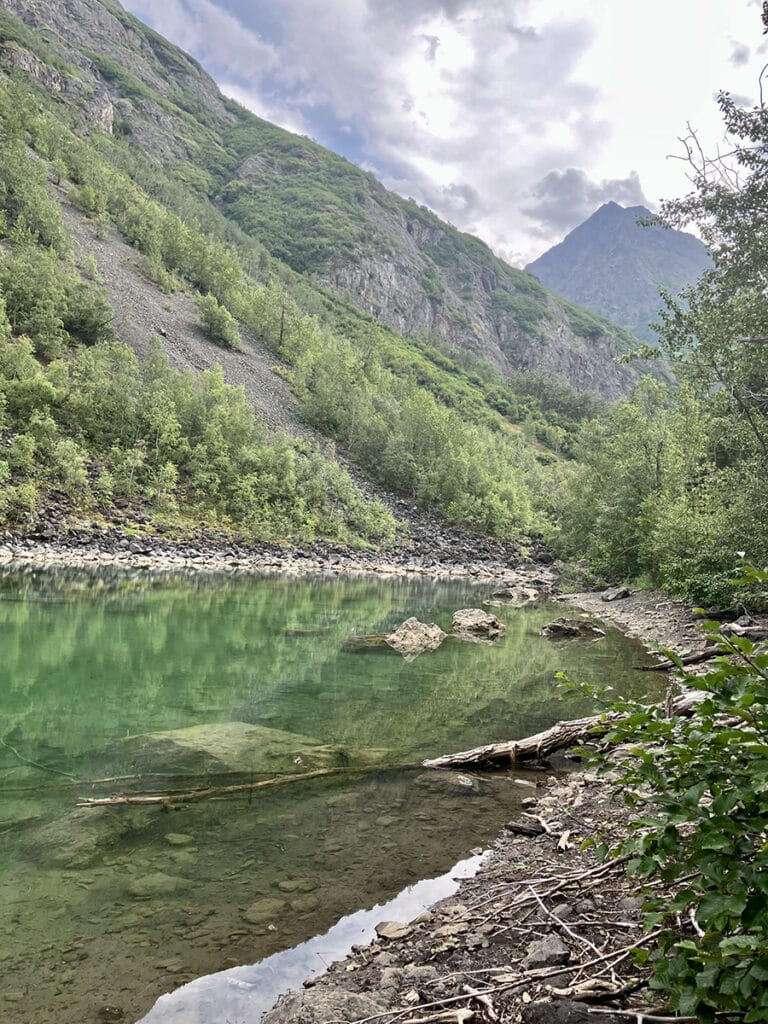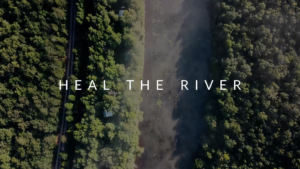Free the Eklutna River

The Eklutna Hydro project currently diverts all water at the outlet of Eklutna Lake. Photo by Tyler Schwab.
The Eklutna People envision a thriving fishery accessible by all.
Right now, we have the power to return a salmon producing stream back to Southcentral Alaska. The effort to restore the Eklutna River has reached a pivotal moment, with the operators of the Eklutna Hydroelectric Project now accepting public comments on their draft Fish and Wildlife Plan to return water to the river.
The plan the operators proposed would leave over a mile of the river dry, would only release a trickle of water, and would not connect the river to the lake and its extensive upstream salmon habitat. The operator’s plan skirts their legally mandated responsibility to make up for their project’s vast impacts to fish and wildlife, while costing local rate and taxpayers $57 million. We have a better idea that can meaningfully help salmon: simply remove the Eklutna dam.
The Eklutna River once hosted bountiful runs of five species of Pacific salmon. The Eklutna People established their village on the banks of the river because of its historic runs of Chinook, coho and sockeye salmon. Since time immemorial, the Eklutna People were fed by the salmon that returned to the river by the thousands. Historical flows averaged over 1,000 cubic feet per second (cfs) (about the size of Eagle River).
That all changed when two hydroelectric projects dammed the river and cut off the flow of water. This decimated the river’s salmon runs. The lower Eklutna Dam was removed in 2018, but the dam at the outlet of the lake continues to divert all water. This dam, the current Eklutna Hydroelectric Project, was purchased by Chugach Electric Association, Matanuska Electric Association, and the Municipality of Anchorage in 1991. The purchasers did not immediately have to meet standards most hydro-electric projects must address. Instead, the purchase agreement gave the utility owners until 2027 to mitigate damages to and enhance fish and wildlife and their habitat affected by the Eklutna Lake dam.

A dry riverbed remains where a mighty, salmon-producing river once was.
While there is no question the dam provided an important and “cheap” source of power for the area, the energy has come at a steep cost to the Eklutna People, the salmon, and the entire watershed ecosystem. The Native Village of Eklutna was not involved in the decision to dam a river they depended on for food and their way of life, and they have received few benefits from the series of hydro projects.
The dams prevented salmon from reaching their spawning habitat in and above Eklutna lake, decimating the runs and cutting off important nutrients to the ecosystem. If the current plan is finalized, the misjustice committed against Eklutna Peoples will continue for the foreseeable future. It will also rob Alaskans of a productive salmon stream in northern Cook Inlet and in the heart of its largest population centers. Returning water and salmon to the river will benefit all Alaskans; it can be a river we as a community can be proud of.
The purchase agreement requires that the utilities work with key federal agencies to develop the Fish and Wildlife Plan. The U.S. Fish and Wildlife Service believes the draft plan does not meet the intent of the purchase agreement because it does not address impacts to the river’s known sockeye salmon run. Sockeye salmon need access to a lake in the early stages of their lifecycle; the lack of fish passage in the draft plan would ensure that Eklutna sockeye would never recover. The lack of fish passage also severely limits the amount of Chinook and coho spawning habitat in the system. The most promising spawning areas are upstream of the lake.

The National Marine Fisheries Service (NMFS) shares similar concerns. The draft plan would only release 40 cfs of water during the summer months, but NMFS has pointed out that substantially higher flows are needed for both Chinook and coho spawning habitat. Both federal agencies maintain that without year-round, higher flows the entire length of the river, this plan fails to meet the intent of the purchase agreement.
Trout Unlimited and the Native Village of Eklutna participated in the technical reviews of the plan development. Many scientific-backed suggestions were offered that provided fish passage past the dam and adequate water supply that supported salmon. However, those proposals were rejected by the utilities’ consultants and their current plan, available for public input right now, was put forward advocating for actions that still costs ratepayers a lot of money, have the potential to jeopardize the city’s drinking water infrastructure and don’t fix the river or restore salmon runs.
After being ignored in the utilities plan development, the Eklutna Restoration Coalition, led by the vision of the Eklutna People and including Trout Unlimited, is calling for the full restoration of the river by simply removing the dam. Recognizing the community’s reliance on this hydroelectric energy source, we propose removing the Eklutna Lake dam within the next decade, when replacement renewable energy is expected to be available.

Kokanee are found in Eklutna Lake, but with the dam in place, these salmon will never reach the ocean and return to the thriving sockeye salmon run they once were. Photo by Native Village of Eklutna.
Also, to address concerns about project costs, Trout Unlimited and The Conservation Fund have committed to help secure supplemental funding to offset project costs to ratepayers. The hydro project currently supplies ~3% of the region’s power. Renewable energy is important, but energy sources cannot claim to be renewable if they come at the expense of another renewable resource. Salmon are one of Alaska’s greatest resources. They drive our economies, sustain our ecosystems, and fill our freezers.
Removing the dam has infrastructure implications to consider beyond power and the coalition’s decision to call for dam removal was not taken lightly. Eklutna Lake provides Anchorage with its drinking water. The intake valve for drinking water is low enough in the lake that removing the dam and letting the lake return to natural levels will not affect the sourcing of water. Additionally, the utilities draft plan also uses Anchorage’s drinking water infrastructure to pipe water from the lake around a 1 mile stretch of dry river bed and back into the Eklutna River. The operators claim this will not have negative impacts on the water supply, but there have not been thorough studies done on how the city’s water supply infrastructure may be impacted.

Waters upstream of the lake could be productive spawning and rearing habitat, but the draft plan ensures salmon will never reach these areas. Photo by Michelle Beadle.
As salmon face declines from a myriad of reasons, the importance of a diverse range of freshwater habitat has become increasingly crucial. Upper Cook Inlet Chinook populations have declined significantly. Restoring their access to an extensive range of historic habitat will only help their numbers.
Dam removal is a costly business, but the current plan is already costing Alaskans $57 million. Two non-profit partners have agreed to raise funds to reduce the cost of dam removal to ratepayers because our salmon are worth it. Imagine the value a thriving salmon stream would bring to southcentral Alaska. The movement to take down river-devastating dams is widespread across the country. We’ve seen the dam removal success stories already.
It’s time to bring this effort north to Alaska. Help free the Eklutna River and return its salmon today.
This post originally appeared on Trout Unlimited.


